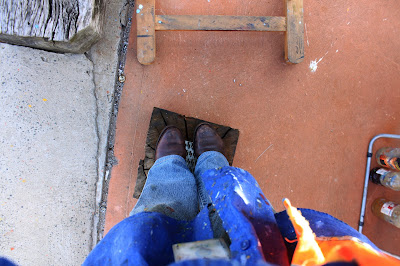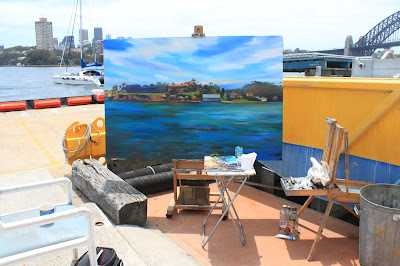The Shirley Smith is now on the slipway on the western side of Goat Island.
The eastern side of the Island which faces Moore's Wharf, features the old amenities block, which was once the site of the iconic TV series "Water Rats", and the heritage cottages which once housed the headquarters of the Harbour Master.
The western side of Goat Island still has an operating shipyard, one of the last vestiges of Sydney's rich heritage as a working harbour.
The only hint of this on the eastern side is the barely visible tip of the crane poking out from the treetops.
 |
Starting a small oil sketch of the "Shirley Smith" on the Goat Island slipway,
oil on canvas 13 x 18cm
|
Several years ago I managed to paint on Goat Island, but it was difficult to arrange access there, and even more importantly, back.
It's a long swim to shore.
I have longed to return to paint on Goat Island, and last week I finally got my wish.
I hitched a ride on the "Mann's Point", courtesy of Sydney Ports Corporation, and painted 2 tiny oil sketches.
 |
Starting a small oil sketch of the "Shirley Smith" on the Goat Island slipway,
oil on canvas 13 x 18cm
|
I had a great vantage point as I was sitting on a jetty directly opposite.
 |
My first small oil sketch of the "Shirley Smith" on the Goat Island slipway, oil on canvas 13 x 18cm |
I might not get the opportunity to return until the end of this week as there have been so many commitments and distractions.
My solo exhibition continues until the end of the month. Once the paintings had been hung, and the official opening was over, I had to organize a panel discussion and an artist's talk.
 |
Another view of my small oil sketch of the "Shirley Smith" on the Goat Island slipway, oil on canvas 13 x 18cm
|
I have left one of my French box easels on Goat Island, to make it easier for me to return with larger canvases.
The people at the shipyard have been wonderful. They are so friendly and easygoing, and have so much passion for the unique maritime heritage of Goat Island.
 |
Starting my second small oil sketch of the "Shirley Smith" on the Goat Island slipway, oil on canvas 15 x 31cm
|
Painting on the island is an inspiring experience, but the trouble is that if I have left something behind, I have to do without until next time.
It can be awkward to take equipment there, and even more awkward to take it back.
I tried to take the bare minimum of stuff in my trolley luggage, but even so I needed help to lug my easel from the boat to the ramp.
 |
My 2nd small oil sketch of the "Shirley Smith" on the Goat Island slipway
oil on canvas 15 x 31cm
|
They were keen to get home, so it was a fast and bumpy Harbour cruise.
It was made even more exciting by having to juggle two small wet canvases and make sure that they didn't fall in the water.


















.JPG)


.jpg)





.jpg)

.jpg)



.jpg)